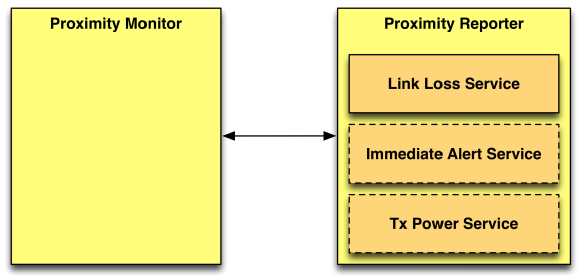Bluetooth Proximity Profile
The Proximity Profile defines two roles intended to allow devices to detect their proximity.
The two roles are called:
- The Proximity Reporter
- The Proximity Monitor

Proximity Reporter
The Proximity Reporter is required to be a Generic ATTribute (GATT) server.
The Proximity Reporter supports the following GATT services:
- Link Loss Service (mandatory)
- Immediate Alert Service (optional)
- Tx Power Service (optional)
Proximity Monitor
The Proximity Monitor is the GATT client. It should create and maintain a connection to the proximity Reporter and monitor the Radio Signal Strength Information (or RSSI) of the connection to calculate the signal's path loss. If the optional Tx Power Service is available on the Proximity Reporter, it can also use this additional information to normalize the RSSI value by subtracting the RSSI from the Tx Power Level.
Support for GATT in Windows
When a GATT device is paired with Windows, the device becomes part of the system. Windows provides device objects to represent both the device and the primary services reported by the device.
The Windows.Devices.Bluetooth.GenericAttributeProfile namespace describes the Generic Attribute Profile APIs app developers can use in Windows.
One of the first steps when developing a device app is to identify which Bluetooth services the app needs in order to accomplish the scenarios a user cares about. For the Proximity Profile, the device app needs to use the Link Loss Service and optionally the Immediate Alert Service and Tx Power Service.
The device app should use the APIs available in the Windows.Devices.Enumeration namespace to determine if any devices paired with Windows implement the Link Loss Service. Specifically, use the DeviceInformation.FindAllAsync method.
The DeviceInformation.FindAllAsync method takes an AQS (Advanced Query Syntax) device selector as a parameter in order to filter only devices that contain the Link Loss Service. Device app developers can also use the GetDeviceSelectorFromUuid or GetDeviceSelectorFromShortId methods of the GattDeviceService class, so they don't need to manually construct the AQS filter.
The Link Loss Service is a Bluetooth GATT service defined by the Bluetooth SIG, and as such a Short Id can be used instead of a fully qualified UUID.
The Short Id service IDs assigned for a Proximity profile service are:
| Service Name | Short Id |
|---|---|
| Link Loss | 0x1803 |
| Immediate Alert | 0x1802 |
| Tx Power | 0x1804 |
The Bluetooth SIG maintains the most up-to-date list of services in the assigned numbers document.
After you determine which service you want to use, call GattDeviceService.FromIdAsync to obtain an instance of the service.
Once you obtain a valid GattDeviceService object, use it to communicate with the device using the Windows.Devices.Bluetooth.GenericAttributeProfile API.
These APIs enable access to specific services and their objects (for example Included Services, Characteristics, and Descriptors), as well as read and write capabilities.
The Bluetooth Generic Attribute Profile - Heart Rate Service sample demonstrates some of these techniques.
Using Power Efficiently
Support for Bluetooth Low Energy in Windows has a strong focus on using power efficiently. This focus includes reducing the power consumption for the local Bluetooth radio adapter and using the CPU to be as little as possible.
Therefore, to establish a Bluetooth LE connection an app needs to register a handler for the GattCharacteristic.ValueChanged event. Alternately, the app must call any of the GattCharacteristic.ReadValueAsync, GattCharacteristic.WriteValueAsync or GattCharacteristic.WriteClientCharacteristicConfigurationDescriptorAsync methods without specifying the BluetoothCacheMode.Cached option.
Note
In order to minimize power consumption, Windows does not actively monitor the RSSI value of the link by polling the local Bluetooth radio controller.
Power considerations are described in Proximity Profile Implementation Details.